Z68 SSD Caching with Corsair's F40 SandForce SSD
by Anand Lal Shimpi on May 13, 2011 3:06 AM ESTAnandTech Storage Bench 2011 - Heavy Workload
Last year we introduced our AnandTech Storage Bench, a suite of benchmarks that took traces of real OS/application usage and played them back in a repeatable manner. I assembled the traces myself out of frustration with the majority of what we have today in terms of SSD benchmarks.
Although the AnandTech Storage Bench tests did a good job of characterizing SSD performance, they weren't stressful enough. All of the tests performed less than 10GB of reads/writes and typically involved only 4GB of writes specifically. That's not even enough exceed the spare area on most SSDs. Most canned SSD benchmarks don't even come close to writing a single gigabyte of data, but that doesn't mean that simply writing 4GB is acceptable.
Originally I kept the benchmarks short enough that they wouldn't be a burden to run (~30 minutes) but long enough that they were representative of what a power user might do with their system.
Not too long ago I tweeted that I had created what I referred to as the Mother of All SSD Benchmarks (MOASB). Rather than only writing 4GB of data to the drive, this benchmark writes 106.32GB. It's the load you'd put on a drive after nearly two weeks of constant usage. And it takes a *long* time to run.
First, some details:
1) The MOASB, officially called AnandTech Storage Bench 2011 - Heavy Workload, mainly focuses on the times when your I/O activity is the highest. There is a lot of downloading and application installing that happens during the course of this test. My thinking was that it's during application installs, file copies, downloading and multitasking with all of this that you can really notice performance differences between drives.
2) I tried to cover as many bases as possible with the software I incorporated into this test. There's a lot of photo editing in Photoshop, HTML editing in Dreamweaver, web browsing, game playing/level loading (Starcraft II & WoW are both a part of the test) as well as general use stuff (application installing, virus scanning). I included a large amount of email downloading, document creation and editing as well. To top it all off I even use Visual Studio 2008 to build Chromium during the test.
The test has 2,168,893 read operations and 1,783,447 write operations. The IO breakdown is as follows:
| AnandTech Storage Bench 2011 - Heavy Workload IO Breakdown | ||||
| IO Size | % of Total | |||
| 4KB | 28% | |||
| 16KB | 10% | |||
| 32KB | 10% | |||
| 64KB | 4% | |||
Only 42% of all operations are sequential, the rest range from pseudo to fully random (with most falling in the pseudo-random category). Average queue depth is 4.625 IOs, with 59% of operations taking place in an IO queue of 1.
Many of you have asked for a better way to really characterize performance. Simply looking at IOPS doesn't really say much. As a result I'm going to be presenting Storage Bench 2011 data in a slightly different way. We'll have performance represented as Average MB/s, with higher numbers being better. At the same time I'll be reporting how long the SSD was busy while running this test. These disk busy graphs will show you exactly how much time was shaved off by using a faster drive vs. a slower one during the course of this test. Finally, I will also break out performance into reads, writes and combined. The reason I do this is to help balance out the fact that this test is unusually write intensive, which can often hide the benefits of a drive with good read performance.
There's also a new light workload for 2011. This is a far more reasonable, typical every day use case benchmark. Lots of web browsing, photo editing (but with a greater focus on photo consumption), video playback as well as some application installs and gaming. This test isn't nearly as write intensive as the MOASB but it's still multiple times more write intensive than what we were running last year.
As always I don't believe that these two benchmarks alone are enough to characterize the performance of a drive, but hopefully along with the rest of our tests they will help provide a better idea.
The testbed for Storage Bench 2011 has changed as well. We're now using a Sandy Bridge platform with full 6Gbps support for these tests. All of the older tests are still run on our X58 platform.
AnandTech Storage Bench 2011 - Heavy Workload
We'll start out by looking at average data rate throughout our new heavy workload test:
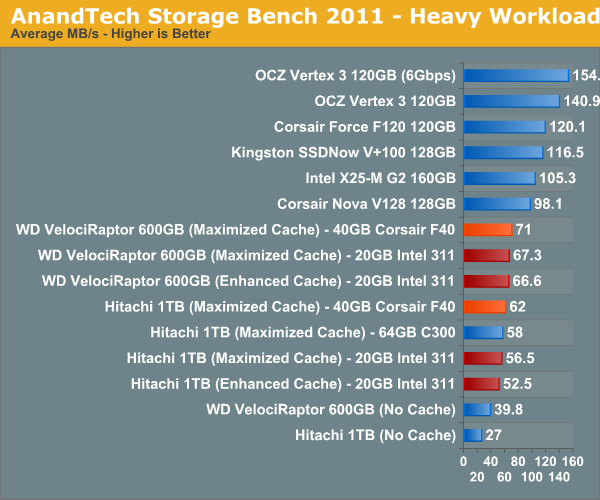
In our launch article we found that even Crucial's 64GB RealSSD C300 wasn't able to significantly outperform the 311, the situation isn't much different with the F40. The good news is that you do get twice the capacity and technically better performance, which could result in more of your data being in the cache at once.
The breakdown of reads vs. writes tells us more of what's going on:
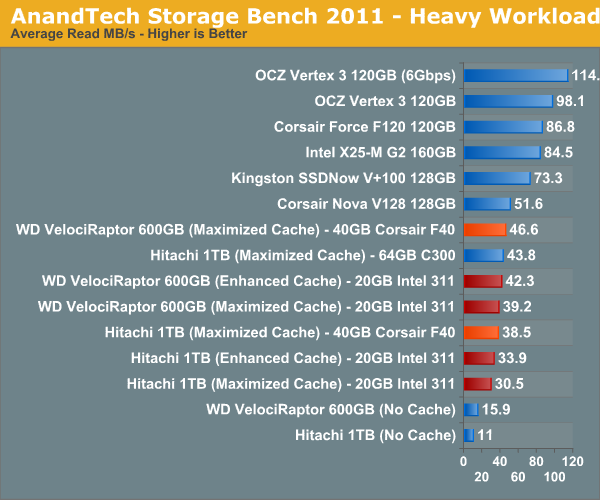
Read performance is actually where the F40 shines, surprisingly enough. This would imply that the majority of reads being cached are highly compressible in nature, playing to the F40's strengths. The write performance is a different story however:
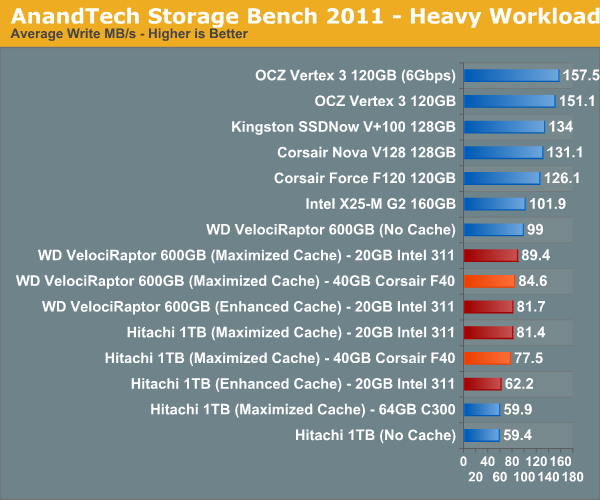
There isn't a huge difference here, but the 311 does pull ahead in the writes that occur during our test. Overall I'd say the F40 and 311 are pretty equal here, which is a good thing given the capacity advantage.
The next three charts just represent the same data, but in a different manner. Instead of looking at average data rate, we're looking at how long the disk was busy for during this entire test. Note that disk busy time excludes any and all idles, this is just how long the SSD was busy doing something:
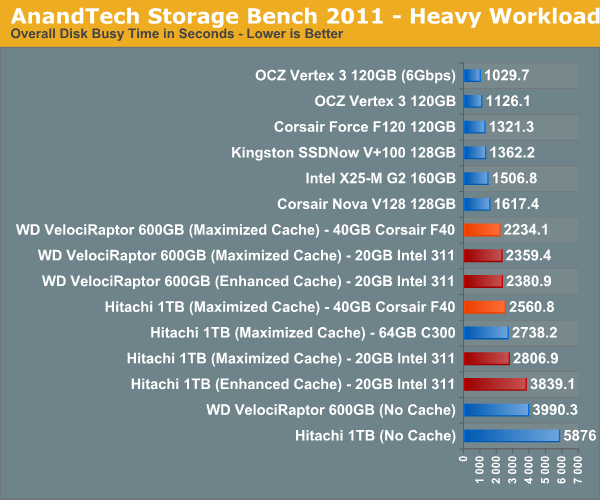

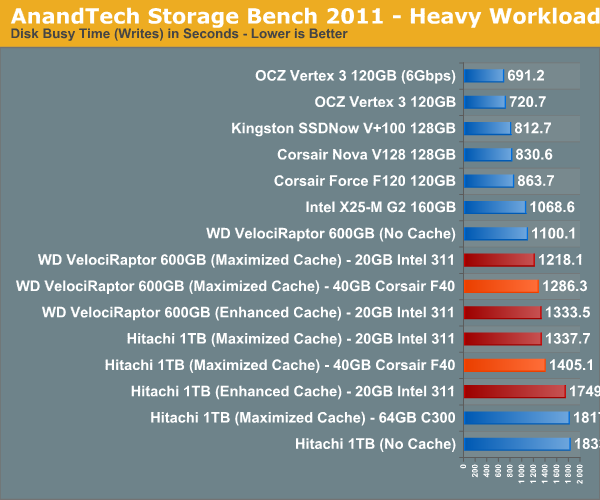










81 Comments
View All Comments
Andreos - Saturday, May 14, 2011 - link
I don't do transcoding and I think the Z68 Virtu hoopla is a one gigantic snooze. None of that is going to save me from having to buy a decent discrete video card.SSD caching is the one thing that sparked my interest in Z68. But the Z68 boards that are coming available online have a price premium over the equivalent P67 board of about $50. An SSD 311 runs $110. That puts you at $160 just to get into the SSD caching game. I'd rather take that $160, kick in another $50, and get a P67 board and a real 120GB SSD. In fact, that's just what I'm going to do!
BTW the Z68 boards have fewer USB ports than the equivalent P67 boards (all those video ports for the integrate video take up real estate).
I think Z68, rather than being frosting on the Sandy Bridge cake, is more like melted ice cream.
Addikt - Saturday, May 14, 2011 - link
After reading these two articles, I don't fully understand what the point of this technology is. I understand that it fills a current void, but how useful is it going to be down the road?With the costs of SSDs continually dropping, and mainstream drive performance increasing, it looks like it will only be 6 months to a year before this technology is obsolete.
It was already highlighted in the previous article that if you have a Vertex 3, you really have no need for this feature. So, in the interim it's bringing SSD-ish performance to mechanical drives, but to what end? Why not just save up your pennies and buy that Vertex 3 that you've always wanted? I mean, this Intel 311 20 GB is going to cost you $100+ anyway.
I just don't see the end-game with respect to this tech. That said, upon reading the comments section, it seems that everyone is so delighted by its arrival, which causes me to question my own understanding of it.
Am I missing something here? Anyone care to enlighten me? I just don't see this as being a really big deal.
slyck - Saturday, May 14, 2011 - link
I feel the same. From the first announcements this looked pretty weak to me. You do get some performance gains but at what cost? Not interested. At all. Waiting til the end of the year to finally make a first SSD purchase(if the prices FINALLY become reasonable. Planned to make first purchase same time last year and the year before.)Pay less for a non-Z68 chipset, save the cost of this overpriced 20GB SSD, and just get a decent sized SSD instead.
xineis - Sunday, May 15, 2011 - link
Intel SSD Caching seems to be a very nice idea! Would SSDs like the Vertex2 or lower end SSDs perform better? Or would they do just the same?Also, could someone explain what is that Random Data that always appears on the graphics?
biofishfreak - Tuesday, May 17, 2011 - link
I've been loving all the numbers about SSDs, but I'm still apprehensive about the whole failure thing- not that I'm worried about the drive itself since I already have a solid backup plan in place- but about the RMA times, shipping costs, and how many times I can get the drive replaced on a single purchase warranty (as in the warranty states 3 years, but does that go out the window after the first replacement?) I'm ok spending ~$200 on a low-to-mid SSD every two years, but I can't afford to do every 6 months.A review and comparison chart of all the manufacturers RMA times, warranty specifics, etc would be great!! SSDs fail, it's a part of life. But do the support centers fail too?
jcollett - Thursday, May 19, 2011 - link
Maybe I missed it, but did this article address that the Intel 311 uses SLC chips while all the other consumer SSDs use MLC? This will be VERY IMPORTANT when using the drive for caching. I would be surprised if the MLC drives last a year at this task. Intel engineers were no fools; they put SLC chips into this drive for a good reason.feathers632 - Friday, May 20, 2011 - link
Based on the video I watched on youtube which as I recall was a gigabyte z68 with SSD caching booting windows next to a regular non SSD system. The Z68 system was maybe 10 seconds faster. A total waste of time.JimmiG - Saturday, May 21, 2011 - link
It's a shame hybrid drives haven't taken off. That's sort of the consumer version of this. Consumers don't want to buy multiple devices or configure anything. It should just work. Compare to how 3D graphics really took off when they began integrating the 2D and 3D cores on the same chip.The problem with just adding a small SSD (64-128GB) to your existing setup, is that you have to manually move the files you *think* you will be accessing most frequently to the SSD. When your usage pattern changes, you have to manually move the application/game you're no longer using as much to your mechanical drive, then move the one you've started using more frequently to the SSD. This usually involves a complete reinstall of the program or game. The same will happen when you run out of space on the SSD.
If the OS or storage controller took care of automatically caching the most frequently used data, it would be much more efficient. It might not even need to cache all application or game data, maybe just some portions of. Windows already does this with Superfetch and Readyboost for smaller amounts of data (a couple of gigabytes). It shouldn't be that hard to extend it to 64+GB.
Stahn Aileron - Tuesday, May 24, 2011 - link
You do realize that Intel's SRT on Z68 is the next step to making Hybrid drives a viable market, right?The scenario you describe is precisely the one SRT is trying to avoid/mitigate/solve: manual data allocation by the user. It's at the chipset and driver level. The difference here is the need for two drives and initial set-up vs. a single drive and (hopefully) simple plug 'n play.
While it'd be nice to have a (good) hybrid drive, I don't foresee 20GB of SLC NAND, one (for laptops) or two (for desktop) HDD platters, and the various controllers for each in a single package any time soon. (If we take Intel's SRT system as an example, you'd need the equivalent of a controller for each the SSD and HDD components, plus a chipset-like controller to tie the two parts together. We'll assume the external SATA connection to the MB is supplied through the chipset-equivalent controller. Not to say this can't all be consolidated into a single-chip solution later on, though.)
I don't see this happening unless a company like Intel, Corsair, Kingston, or OCZ partners up with a HDD manufacturer like WD or Seagate.
I'd love to see somethng like a co-branded Intel/WD Hybrid drive or something equivalent. (Would "hybrid drive" be abbreviated as HYD?) I think it'd do wonders for the single-drive ultraportable laptop market.
Hrel - Tuesday, May 31, 2011 - link
If Intel got a 40GB one of these out for sale at 79 bucks I'd buy it.I'd really like to see you add some striped RAID with and without a cache results to these charts though. Otherwise very good article. I really like seeing the results for application/game launch and level load times; as those are "real world" where as 4KB random writes aren't as much and 4KB is pretty irrelevant anyway. As long as the drive can handle writing 4KB/second or more I think I'm good, haha.